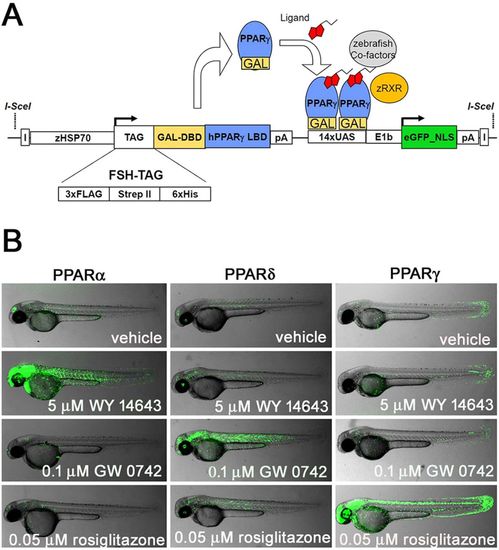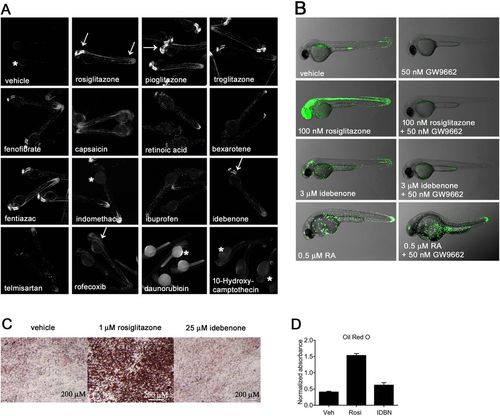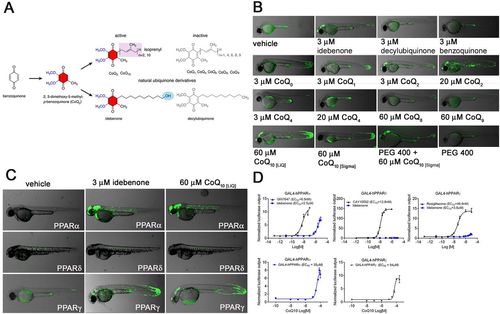- Title
-
Idebenone and coenzyme Q10 are novel PPARα/γ ligands, with potential for treatment of fatty liver diseases.
- Authors
- Tiefenbach, J., Magomedova, L., Liu, J., Reunov, A.A., Tsai, R., Eappen, N.S., Jockusch, R.A., Nislow, C., Cummins, C.L., Krause, H.M.
- Source
- Full text @ Dis. Model. Mech.
|
PPAR LT fish. (A) In the ligand trap (LT) system (Chawla et al., 1994), a DNA-binding domain (DBD)–human nuclear receptor ligand-binding domain (LBD) fusion protein is used to signal the presence of ligand in vivo. In the presence of specific ligands and cofactors, binding of the fusion protein to a GFP reporter results in expression of GFP. Previously published by Tiefenbach et al. (2010) under a CC-BY license (https://creativecommons.org/licenses/by/4.0/). (B) 2 dpf PPARα, PPARδ and PPARγ LT fish respond to endogenous fish hormones and PPAR-specific agonists. Active concentrations were similar to those observed in human cells, and non-specific cross-receptor activities were not observed for any of the tested agonists on the other two PPAR receptors (mean n=5). EXPRESSION / LABELING:
|
|
Analysis of hits. (A) Pictures of laser-scanning cytometer-imaged hits in 2 dpf embryos. 1% DMSO was used as vehicle and 50 nM rosiglitazone as positive control. At 1 µM screening concentration, 12 hits were identified. Images show close ups from re-screens at 10 µM concentrations. Idebenone and false positives (last two images) were treated with 3 µM concentrations due to lethality at 10 µM (mean n=5, replicated two times). Arrows indicate sites of GFP expression. Asterisks indicate nonspecific background. (B) At the stage shown (2 dpf), vehicle-treated LT-PPARγ transgenic embryos show weak responses to endogenous ligands and cofactors and strong responses in the presence of the receptor-specific full agonist rosiglitazone in the CNS, heart, blood, renal tube and eye. Idebenone treatment leads to relatively lower and more restricted GFP expression in cells of the blood, epidermis and CNS. 9-cis-retinoic acid (RA) increases GFP expression in keratinocytes, in the tail bud and in epidermis, presumably through activation of the zebrafish RXR receptor. The GW9662 suicide antagonist blocks agonist activity of rosiglitazone and idebenone, but not of RA. Overlay pictures of bright-field and GFP (85% transparent) from 2 dpf embryos are shown. Views are lateral with anterior to the left (mean n=10, replicated two times). (C) The treatment of murine 3T3-L1 pre-adipocytes with rosiglitazone in the presence of dexamethasone, isobutylmethylxanthine and insulin results in the accumulation of intracellular lipids. In contrast, cells treated with vehicle (DMSO) or idebenone (IDBN) instead of rosiglitazone showed no accumulation of lipid (Oil-Red-O staining). Images were taken at 100× magnification with a Leica M205 FA microscope. (D) Oil-Red-O staining quantification from cells shown in C. Oil-Red-O dye was eluted using isopropanol and absorbance was measured at 505 nm. Data represent mean±s.d., n=3. EXPRESSION / LABELING:
PHENOTYPE:
|
|
Benzoquinone structures and hPPAR activities. (A) Structures of idebenone, CoQ10 and derivatives. Note that the isoprenoid side chain contains ten isoprenoid subunits, whereas idebenone contains only alkyl units and ends with a polar hydroxyl group. (B) 2 dpf PPARγ LT embryos showing limited GFP expression in a small subset of epidermal cells and in the posterior spinal cord in the absence of exogenous ligand. Treatment with idebenone, CoQ2 or CoQ10 induces similar patterns of GFP expression in cells of the epidermis, blood, CNS and posterior spinal cord. Decylubiquinone, which carries a methyl group instead of the hydroxyl group, does not activate the receptor. Benzoquinone, CoQ0, CoQ1, CoQ4, CoQ6, CoQ8 and CoQ9 showed no reporter activation. Pure CoQ10 (Sigma), which has weak water solubility, shows strong receptor activation when mixed together with PEG. Overlay pictures of bright-field and GFP (85% transparent) of 2 dpf embryos are shown. Views are lateral with anterior to the left (mean n=20, replicated three times). (C) Idebenone and CoQ10 are partial dual agonists of PPARα and PPARγ. Embryos of the PPARδ fish line show no increased GFP expression in the presence of CoQ10 or idebenone. Overlaid bright-field and GFP images (85% transparent) of 2 dpf embryos are shown. Views are lateral with anterior to the left (mean n=10, replicated three times). (D) HEK293 cells were co-transfected with the GAL4-LBD fusion proteins of hPPARα, hPPARδ and hPPARγ (as indicated) together with a UAS-luciferase reporter. Treatment of the cells with the full agonists GW7647 (hPPARα), CAY10592 (hPPARδ/β) or rosiglitazone (hPPARγ) resulted in EC50 concentrations of 8 nM, 12.8 nM and 48 nM, respectively. Treatment with idebenone resulted in an EC50 of 2.5 µM for PPARα and 3.8 µM for PPARγ. Notably, maximal activation levels were far lower than elicited by the full agonists. Luciferase output was normalized to β-galactosidase to control for transfection efficiency and expressed as normalized luciferase output. Plasmids used were: pCMX, pcDNA3-GAL4-hPPARα, pcDNA3-GAL4-hPPARδ, pcDNA3-GAL4-hPPARγ, UAS-luc, pGEM, pCMX–β-galactosidase. Data represent mean±s.d., n=3 with at least three repeats. |
|
Variability of GFP responses in PPAR ligand trap embryos. GFP responses in 2 dpf heterozygous PPARγ embryos are shown. Panels on the left show responses to endogenous ligand and cofactors in 3 different embryos. Signals are seen in the tail bud, as well as in the posterior spinal cord and skin, GFP (indicated by arrows). PPARγ embryos treated with idebenone (center panels), or rosiglitazone (right panels) show increased GFP expression in the tail bud and posterior spine as well as additional expression in the CNS and eye (indicated by arrows). Auto-fluorescence in the yolk is indicated by asterisks. Rosiglitazone treatment also elicited GFP expression in the heart (right panel upper image, indicated by arrow). Views are lateral with anterior to the left (avg n=10, replicated 20 times). |




